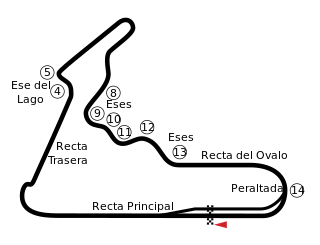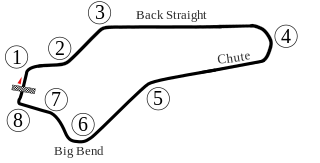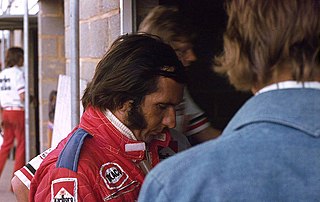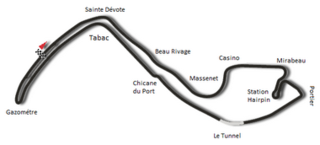
Karl Jochen Rindt was a German-born racing driver who competed with an Austrian license during his career, despite having German and not Austrian citizenship. In 1970, he was killed during practice for the Italian Grand Prix and became the only driver to be posthumously awarded the Formula One World Drivers' Championship.

The 1960 Italian Grand Prix was a Formula One motor race held at Monza on 4 September 1960. It was race 9 of 10 in the 1960 World Championship of Drivers and race 8 of 9 in the 1960 International Cup for Formula One Manufacturers. The race was won by American driver Phil Hill driving a Ferrari 246 F1.

The 1965 Mexican Grand Prix was a Formula One motor race held at Ciudad Deportiva Magdalena Mixhuca in Mexico City on October 24, 1965. It was race 10 of 10 in both the 1965 World Championship of Drivers and the 1965 International Cup for Formula One Manufacturers. The race was won by Richie Ginther, who took his first and only victory, first for the Honda team and, excluding the Indianapolis 500, first win for the non-European team, after leading for the entire race. The Brabham-Climax of Dan Gurney finished the race second and the Lotus-Climax of Mike Spence completed the podium.

The 1966 United States Grand Prix was a Formula One motor race held on October 2, 1966, at the Watkins Glen Grand Prix Race Course in Watkins Glen, New York. It was race 8 of 9 in both the 1966 World Championship of Drivers and the 1966 International Cup for Formula One Manufacturers. The race was the ninth United States Grand Prix. It was the sixth to be held at Watkins Glen. The race was held over 108 laps of the 3.78-kilometre circuit for a total race distance of 408 kilometres.

The 1966 Mexican Grand Prix was a Formula One motor race held at the Ciudad Deportiva Magdalena Mixhuca on 23 October 1966. It was race 9 of 9 in both the 1966 World Championship of Drivers and the 1966 International Cup for Formula One Manufacturers. The race was the fifth Mexican Grand Prix and the first to be run under the new three-litre Formula. It was held over 65 laps of the 5 km (3.1 mi) circuit for a race distance of 325 km (202 mi).

The 1969 German Grand Prix was a Formula One motor race held at Nürburgring on 3 August 1969. It was race 7 of 11 in both the 1969 World Championship of Drivers and the 1969 International Cup for Formula One Manufacturers. Twelve Formula Two cars were also entered into the race, though they were not eligible to score points.

The 1969 Italian Grand Prix was a Formula One motor race held at the Autodromo Nazionale di Monza on September 7, 1969. It was race 8 of 11 in both the 1969 World Championship of Drivers and the 1969 International Cup for Formula One Manufacturers. The race was notable in that less than a fifth of a second separated the winner from the fourth-placed driver, and is one of the closest 1–2–3–4 finishes in Formula One history. Jackie Stewart and Matra-Ford claimed the Drivers' and Manufacturers' titles respectively, with three races still remaining.

The 1969 Canadian Grand Prix was a Formula One motor race held at Mosport Park on September 20, 1969. It was race 9 of 11 in both the 1969 World Championship of Drivers and the 1969 International Cup for Formula One Manufacturers. The 90-lap race was won from pole position by Belgian driver Jacky Ickx in a works Brabham-Ford, with teammate Jack Brabham second and Jochen Rindt third in a works Lotus-Ford.

The 1969 United States Grand Prix was a Formula One motor race held on October 5, 1969, at the Watkins Glen Grand Prix Race Course in Watkins Glen, New York. It was race 10 of 11 in both the 1969 World Championship of Drivers and the 1969 International Cup for Formula One Manufacturers. The 108-lap race was won by Lotus driver Jochen Rindt after he started from pole position. Piers Courage finished second for the Brabham team and BRM driver John Surtees came in third.

The 1969 Gran Premio de Mexico was a Formula One motor race held at the Ciudad Deportiva Magdalena Mixhuca, Mexico City on October 19, 1969, two weeks after the United States Grand Prix at Watkins Glen. It was race 11 of 11 in both the 1969 World Championship of Drivers and the 1969 International Cup for Formula One Manufacturers. The 65-lap race was won by McLaren driver Denny Hulme after he started from fourth position. Jacky Ickx finished second for the Brabham team and his teammate Jack Brabham came in third.

The 1970 British Grand Prix was a Formula One motor race held at Brands Hatch on 18 July 1970. It was race 7 of 13 in both the 1970 World Championship of Drivers and the 1970 International Cup for Formula One Manufacturers.

The 1970 Mexican Grand Prix was a Formula One motor race held at the Ciudad Deportiva Magdalena Mixhuca in Mexico City on October 25, 1970. It was race 13 of 13 in both the 1970 World Championship of Drivers and the 1970 International Cup for Formula One Manufacturers. The 65-lap race was won by Ferrari driver Jacky Ickx after he started from third position. His teammate Clay Regazzoni finished second and McLaren driver Denny Hulme came in third.

The 1972 Formula One season was the 26th season of the FIA's Formula One motor racing. It featured the 23rd World Championship of Drivers, the 15th International Cup for F1 Manufacturers and numerous non-championship Formula One races. The World Championship season commenced on 23 January and ended on 8 October after twelve races.

The 1971 Formula One season was the 25th season of the Fédération Internationale de l'Automobile's Formula One motor racing. It featured the 22nd World Championship of Drivers and the 14th International Cup for F1 Manufacturers which were contested concurrently over eleven races between 6 March and 3 October. The season also included a number of non-championship races open to Formula One cars.

The 1970 Formula One season was the 24th season of the FIA's Formula One motor racing. It featured the 21st World Championship of Drivers and the 13th International Cup for F1 Manufacturers. Thirteen races were held between 7 March and 25 October, with the Drivers' Championship won by Jochen Rindt and the Constructors' title by Lotus. Rindt died four races before the end of the season, but had earned enough World Championship points that no other driver managed to surpass his total by the end of the season. It is the only season to date in which the World Drivers' Championship title had been awarded posthumously. Jacky Ickx driving for Ferrari finished the season strongly, but his low 4th-place finish in the penultimate round ensured that Rindt's title lead would stand. In the end, all of Rindt's 45 points came from his five wins in the season.

The 1968 Formula One season was the 22nd season of the FIA's Formula One motor racing. It featured the 19th FIA World Championship, which commenced on 1 January, and ended on 3 November after twelve races, and numerous non-championship races. Graham Hill won the second of his World Championship titles, with Lotus.
The 1966 Formula One season was the 20th season of FIA Formula One motor racing. It featured the 1966 World Championship of Drivers and the 1966 International Cup for F1 Manufacturers which were contested concurrently over a nine-race series that commenced on 22 May and ended on 23 October. The season saw the "return to power" with the introduction of the '3 litre formula', doubling maximum engine capacity from 1.5 litres. Jack Brabham won the World Championship of Drivers and Brabham-Repco was awarded the International Cup for F1 Manufacturers.
The 1955 Formula One season was the ninth season of FIA Formula One motor racing. It featured the 1955 World Championship of Drivers, which commenced on 16 January 1955 and ended on 11 September after seven races. Juan Manuel Fangio won his second consecutive World Championship title in a season curtailed by tragedies.

The Lotus 49 was a Formula One racing car designed by Colin Chapman and Maurice Philippe for the 1967 F1 season. It was designed around the Cosworth DFV engine that would power most of the Formula One grid through the 1970s. It was one of the first F1 cars to use a stressed member engine combined with a monocoque to reduce weight, with other teams adopting the concept after its success. It also pioneered the use of aerofoils to generate downforce.














